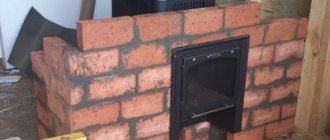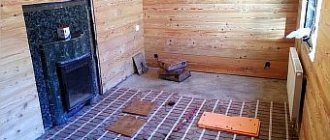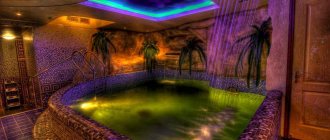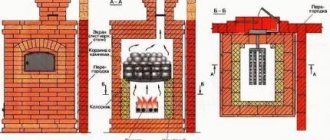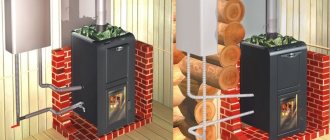- How can I lay out a portal under the stove in a wooden bathhouse?
- Made of metal
- Facing cladding
It is important not only to install a heating unit of suitable power, but also to provide all the conditions for its proper operation. Therefore, let's talk about constructing a portal for a brick sauna stove. We have collected as much useful information as possible for you so that you understand how to correctly implement one of the key stages in creating a comfortable microclimate and ensure your own safety.
General description of the design
In fact, this is a special frame made around the heating source. U-shaped, it, as a rule, visually stands out from the general background, although it can be made of the same material as the masonry. Its other common names are “gate” or “front entrance”, given precisely because of its appearance.
It can go both into the living room - a separate kindling room - and into the rest room. In the latter case, the aesthetics of execution are especially important.
An already finished structure cannot be adjusted in any way - if changes are needed, it will have to be built anew. Therefore, it is worth paying special attention to its design: to calculating the dimensions and quantity of materials.
When a portal needs protection
In the event that the room is small, and the heating equipment is too powerful and therefore not only heats itself up, but also overheats everything around, including the surrounding air. In such a situation, the frame must be made of heat-resistant material to prevent its rapid failure. At the same time, you will protect yourself from burns and excess heat.
Why do you need a portal for the stove in the bathhouse?
It performs several functions at once:
- Practical - covers the places where the walls meet the insulation of the fuel channel, preventing drafts and destruction of the masonry.
- Aesthetic – when properly finished, it is a stylish design element that visually decorates the remote firebox and the interior of the room as a whole.
- Protective – absorbs excess heat, preventing the air in the room from overheating, and also prevents accidental touches to the hot metal surfaces of the firebox.
It turns out that both the safety and the duration of the trouble-free functioning of the steam room, and even the general appearance of the room, depend on its presence.
Dimensions
When determining dimensions, it is necessary to comply with safety requirements and evaluate the dimensions of the room and stove. Before building a structure, it is necessary to correctly calculate the dimensions and the project as a whole. Remaking the structure is practically impossible only if you break it down and rebuild a new portal. The size of the future portal and decorative design depend on the scale of the oven.
Important criteria must be taken into account when designing :
- Height and width of the stove;
- Clearance width (when the furnace wall expands and heats up during operation);
- Masonry technique;
- Calculation of the width gap between the masonry and the wall of the bathhouse.
When calculating the number of components for the portal, you need to divide the area of the masonry by the area of one side of the building material (multiply the width of the element by its length). Another 10% of the total amount of laying material is added to this value. This will help to avoid shortcomings in the event of damage and breakage of building fragments.
Important! According to SNiP rules, the shortest distance from the stove to the combustible wall material is at least 38 cm. The height is below the top edge of the stove.
The sides can have a size from 30 to 50 cm. It is better to take more than to start a rework later. The height of the portal can be extended to the ceiling, or limited to a comfortable height. The shape of the structure can be either rectangular or square, if the dimensions are greater in height than in width.
Features of the portal for the stove in the bathhouse
During operation, the heating unit becomes hot. The heat released in this way affects both the air and all surfaces of the room. And if the heating of the wooden walls adjacent to the firebox is too strong, they can char, begin to smolder (already at 100°C) or even catch fire (at 300°C).
To prevent a fire, shielding is done - precisely with the help of “gates”, frontal or side, depending on the location of the channel, which in the first case goes into the steam room, in the second - into the adjacent cabin, recreation area or even onto the street.
Properly implemented, the “front entrance” completely and reliably covers all fire hazardous areas in the room, and also protects each wooden element from fire. You can buy it ready-made.
How can I lay out a portal under the stove in a bathhouse?
Suitable materials include:
- brick;
- a natural stone;
- tree;
- metal;
- tile;
- drywall.
Now let's look at the most popular solutions in more detail.
Tree
Both noble and simple breeds are widely used. “Gates” are made from boards, timber, plywood and even from laminated chipboard or MDF boards.
An indisputable advantage is the ability to implement a variety of design solutions. You can imitate dozens of natural structures, cut out sophisticated patterns and detailed images.
The main disadvantage is the deformation of the material over time - to reduce the likelihood of this undesirable effect, experts use one or more of the following solutions:
- pre-dry the wood with special care;
- make concrete or stone inserts, install a heat-reflecting screen;
- use rocks of different hardness (but always with good fire resistance);
- the future “gates” are varnished, and they are covered in several layers;
- glue boards or beams together, but only with a non-water-based composition.
Drywall
It attracts with its light weight (with sufficient strength) and affordable cost, but it must be additionally finished - for the aesthetics of its appearance - for example, painted or plastered. You can also line it with artificial stone - this is also a common decorative solution.
Metal
It serves either as a frame - a supporting structure for less solid materials, or as a decorative element when decorating the stove portal in a bathhouse. With the help of corners and stripes, they decorate the “gate” quite effectively, while at the same time using such practical advantages as resistance to temperature changes and easy cleaning.
True, you need to remember about the strong heating of the same steel or cast iron: if you touch such a shield during the kindling process, you can get a serious burn. Therefore, exclusively sheet “front entrances” are not relevant; combined ones, for example, tiled ones, are much more widely used.
Stone
Its advantage is its solidity and even respectability of appearance: decorate the firebox with it, and the analogy with a classic fireplace will simply suggest itself. Moreover, both natural and artificial varieties are suitable. Among the most popular volcanic and metamorphic options:
- soapstone;
- granite;
- slate;
- coil.
They can be used to make a frame located in close proximity to the door. At some distance from the fire, it is permissible to use sedimentary rocks that do not absorb soot, for example, marble, shell rock, travertine, sandstone.
The material can withstand temperature changes better than plasterboard or wood, but it is also more expensive and weighs more - when choosing, keep in mind that it puts more stress on the supporting elements.
Tile
It attracts with its beauty: it can be with a smooth glossy or embossed coating, with an ornament or pattern of any degree of complexity. It does not absorb soot, is not afraid of moisture, and does not require special care, which is also convenient. True, it can crack when heated, which means it is used only as a cladding, which is laid on a heat-resistant base.
In such a situation, brick looks like a priority choice, so below we will separately and in detail consider what advantages it has and how to make a portal in a bathhouse from it. But first, some more useful information about general actions.
Preparation of tools and materials
An experienced specialist will need:
- cement-sand mixture;
- metal profiles;
- minerite;
- basalt cardboard;
- wood glue;
- self-tapping screws;
- Master OK;
- level-level;
- screwdriver (drill);
- jigsaw;
- clamps.
Construction process
When starting work, the master performs the following actions:
- Cuts a rectangular hole in the wall - in the place where you are going to install the remote firebox and in accordance with the dimensions indicated in the passport of the heating unit (at a distance of 30-100 cm on both sides from the center of the channel).
- Mounts a metal frame made of profiles in the resulting opening, fixing sheets of mineralite on it, filling the gaps with masonry of 2 bricks.
- Places basalt cardboard in the provided gap (for insulation).
To fasten the stone, a cement-sand mixture is used, plywood and drywall are fixed with self-tapping screws, and wooden boards are also fixed with glue. The upper part of the “gate” can be turned into a shelf.
Look at the photos of sauna stoves: portals can be designed in dozens of different options, each more attractive than the other. Charge yourself with an idea and turn it into an easy-to-implement project.
Calculation and dimensions
This is a mandatory step, which allows you to determine the width and height of the frame in relation to the firebox, as well as the consumption of building materials.
Having chosen the appropriate dimensions, it is necessary to find the area of the structure and provide a margin on each side. For example, with a built-in opening of 1.5 x 1.5 m, the “front entrance” should be approximately 0.7 by 0.5 m.
Based on this, it will not be difficult to calculate the number of stones or bricks needed: you just need to divide the area - total and piece - and take an additional 10% of the resulting number.
Step-by-step installation instructions
After calculations and design on paper, the specialized specialist begins the actual work:
- Mix the solution using cement and sand of medium or fine fraction.
- Lays bricks - sequentially, from the base, one level after another.
- Takes into account the ligation of seams when creating rows - they should go like a “ladder”, and not an even vertical line.
- Use jointing when the masonry of the portal for the sauna stove is completed to prevent surface roughness.
Afterwards, you can additionally decorate the “front entrance”, for example, with tiles, but this is not necessary, since if the work is done correctly, it already looks quite aesthetically pleasing.
Preparation of the solution
Before finishing the stove in the steam room of the bath, it is necessary to prepare a masonry mortar. To do this, you need to choose the optimal ratio between clay and sand. This can be done by mixing a small portion and rolling it out into a thin cylinder. Then they fold it into a ring and look at the walls. If no cracks have formed, then the solution is of the highest quality.
Modern craftsmen use a different composition to finish a sauna stove. It includes Portland cement, sand and tile adhesive. All ingredients are mixed and work begins. With this composition, the brick holds quite tightly, which guarantees the durability of the masonry. But cement in the solution can have a negative effect when heated. So the choice will remain with the owner of the bathhouse.
Tags: bathhouse, framing, oven
« Previous entry
How to Frame
Here you need to remember that it must be reliable and at the same time look beautiful. Theoretically, you can make a wide range of construction and design decisions: give preference to a combination of drywall and tiles, wisely using the advantages of both materials, and play on the solidity of natural stone. The choice of a specific option depends on a combination of the following factors:
- how the walls are finished, how high their fire resistance is;
- how the room is decorated, what design reigns in the interior;
- what budget do you have and how much are you willing to spend on the “gate”;
- do you have construction skills and/or practical experience working with any material;
- what you personally like best and best suits fashion trends.
The classic solution today is finishing the stove portal in a brick bathhouse with tiles. It is not subject to decay or fire, is relatively inexpensive and allows you to bring almost any design idea to life.
Possible difficulties
Fitting and cutting - in practice, these operations take too much time. Therefore, it is easier to calculate the length and height of the “front entrance” in order to use only whole bars, boards and other piece products.
The presence of a door at the firebox can make access difficult. If it is removable, it is better to dismantle it, carry out all the work calmly, and then install it again.
Vertical and horizontal deviations arise not only due to lack of experience, but also due to uneven floors or walls. So it is imperative to carry out constant level checks - it will help to avoid mistakes.
Gate equipment
Another way to combat increased draft, which causes wood to burn out too quickly and not completely, is to install a damper on the chimney.
A damper is a valve that closes the chimney exhaust duct and blocks the draft:
- In the closed position there is practically no draft - almost no air is sucked in through the blower and combustion doors.
- In the fully open position of the gate, the thrust is maximum - this is the kindling mode.
- By partially retracting the damper, you can reduce the draft so that the wood does not burn, but smolders. This way you can steam on one tab longer than usual.
In factory long-burning furnaces, the gate is made rotary. In a summer cottage it is easier to make it movable. To do this, you just need to cut the sheet to size and make a gap in the chimney. You can pull out such a flap by the tongue.
More about protective screens
They are used to protect the surfaces closest to the heating unit from the harmful effects of emitted infrared radiation, reducing the spread of infrared waves.
They are panels, sheet or built (depending on the material used) around the entire perimeter, in a corner or in some part of the room. There can be two types.
Made of metal
They are made of steel or cast iron, fixed around the heating device, with the required clearances. Small distances are necessary to maintain proper air convection. To ensure the possibility of adjustment, they are not fixed rigidly - with bolts on the floor.
There are 2 types of them:
- frontal - exposed to direct infrared radiation coming from the firebox;
- lateral - perceive already reflected infrared waves.
They become even more effective after painting with a fire-resistant composition.
Made of brick
Such protection is laid out after you have equipped the portal for the stove in the bathhouse - in half a brick (fireclay, hollow, fireproof), with technological gaps measuring 6 cm or more and with air ducts in the lower part, located at a distance of over 25 mm from each other.
The erected screen should rise 25-30 cm above the firebox, then it will fully reveal all its advantages, namely:
- stability in conditions of high humidity and temperature;
- low thermal conductivity, and hence the risk of injury - accidental burns are practically excluded;
- transfer of soft heat from the heating unit;
- long-term preservation (accumulation) of heat.
Preparation of material
Only large cobblestones are suitable for a closed heater
Not all cobblestones are suitable for a bathhouse. The easiest way to find suitable materials is to go to a specialty store, where they will offer a lot of options to choose from. They are significantly different from stones of natural origin, which not only will not bring benefits, but will also harm your health. The main characteristics by which you need to make a choice are:
- Heat resistance is the ability of a material to withstand high temperatures.
- Heat capacity is the ability of cobblestones to retain heat.
- Environmental friendliness. Many materials can release harmful substances when heated.
- Capacity for thermal expansion. The less the stones expand in volume when heated, the better.
The size of the material is very important. It depends on the type of heating device. Small-sized specimens are suitable for electric stoves, but for wood-burning stoves with an open heater, filler of various sizes is suitable - from 6 to 20 cm in diameter.
Wall decoration
It is a “pie” made of a thermal insulation layer and a metal sheet. The first reflects the received energy and distributes it evenly, the second prevents smoldering and fire.
You can choose one of the following insulation materials:
- basalt cardboard – characterized by excellent insulating properties, including noise absorption, and is not subject to rotting;
- mineral wool – non-flammable, resistant to stable exposure even to very high temperatures;
- BSTV (bazvata) is environmentally friendly, but hygroscopic.
Facing cladding
It is attached with a binding solution to a heat-insulating base - for the decoration of the “gate”. Look at the photos of the portals of sauna stoves designed in this way - they look very impressive.
The following materials are in demand for decoration:
- tile terracotta - made of baked clay, durable, wear-resistant, resistant to mechanical stress, with the possibility of painting and glazing;
- clinker - similar to the previous one, only of a different shape (resembles a brick);
- tile - with a decorative surface covered with patterns, prints, ornaments of any complexity;
- porcelain stoneware - with a chic texture that imitates noble stone, non-flammable, effectively resisting abrasion;
- soapstone - with special resistance to impacts, environmentally friendly, interesting gray-green shade.
Construction of a foundation made of rubble concrete
For laying the base of a sauna stove, the strength of the clay mixture is not enough. A regular mortar based on cement and sand will do. The most common foundation is made of rubble concrete.
Stages of work:
Digging a pit with a depth of 1 - 1.2 cm in dimensions exceeding the dimensions of the stove by 15 - 20 cm. Compaction of the soil with suitable cuttings of timber or logs. A timber measuring 100×100 mm is suitable. Laying crushed stone and compacting it to a layer 15 cm thick. Installing formwork. Waterproofing of its internal surface is required. Laying rubble 20 - 30 cm.
The maximum size of individual rubble stones is no more than 15 cm. Filling small fractions of voids between stones with crushed stone. Laying concrete mortar. Concrete must fill all the voids, for which its consistency is chosen to be similar to sour cream. This stage is repeated the required number of times until the desired height of the foundation. Laying the last layer of stones.
Ensuring a level height of 6 - 7 cm to the finished floor Controlling the horizontality of the surface Drying the concrete covered with a film for 15 - 30 days Dismantling the formwork Isolating the side foundation surfaces from water. You can isolate the foundation from water at the stage of its construction by adding special additives to the solution. Filling the space between the foundation and the edges of the pit with sand. A gap of at least 5 cm is required between the bathhouse and stove foundations. It must be filled with sand.
More about firebox rules
For your own safety, as well as for long-term, normal and problem-free operation of the heating unit and “gate”, adhere to the following recommendations:
- Splash water onto the stones carefully, without flooding them, in small portions - 50-100 ml, gradually reducing this volume.
- Use a fan to wet as much of the area as possible.
- Try to direct the liquid between the stones to obtain the hottest and dryest steam possible.
- Follow the sounds - when you hear the water hissing, you will understand that the temperature in the room is dropping.
- Pay attention to the color of the soaked stones - if they acquire a crimson glow, it means you are steaming correctly.
